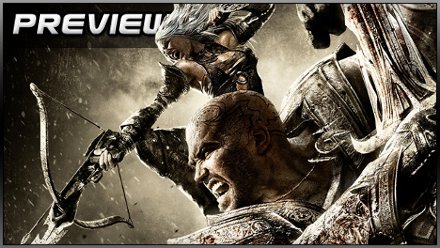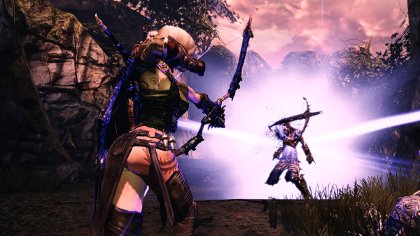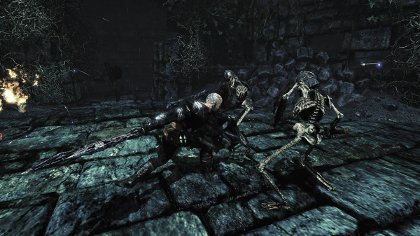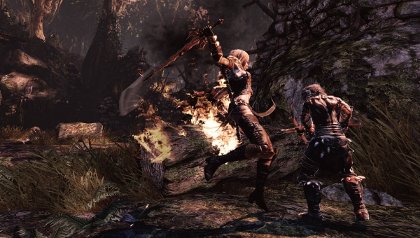
There’s a key line of dialogue towards the beginning of Hunted: The Demon’s Forge, a pivotal point in the game’s opening hour. Big sweaty bald man Caddoc and foxy Elf chum E’lara are strolling through a ruined temple one morning when they’re accosted by an enormous pair of spectral bosoms.
“Hi you guys, I’m Seraphine,” husks the enormous pair of spectral bosoms, not in precisely those words. “See that funny green crystal on the plinth with the skeleton slumped against it? That’s a deathstone, and it can bring you unimaginable riches and power. Why don’t you pick it up?”
Our heroes glance at each other. “But it’s a deathstone,” ventures Caddoc, after a pause. “Next to a dead body.”
Erik Wolpaw could have done more with the material, but I chuckle nonetheless, and that chuckle says a lot. To be precise, it says: “Thank the gods. Hunted: The Demon’s Forge may be a game where sultry waifs who have trouble seeing their own belly buttons foist ominously-named artefacts on passers-by. It may be a game with runes and loincloths and monsters that look like wrestlers draped in radioactive Pot Noodle.
“And it may be a game where the man speaks Cockney because dude, that’s way manlier than regular English, while the woman talks posh because mate, everybody knows that elves are posh. But it retains just enough wit and insight to realise how truly ludicrous all this truly, truly is.”
When VGD spoke to InXile Entertainment president Matt Findley last March about the Californian studio’s new action role-player, he was careful to distinguish between Hunted’s “dark fantasy” and the so-called “high fantasy” of games like Baldur’s Gate. The difference will probably be lost on those to whom one set of pointy ears or hats is much like another, and when Findley splits hairs during our hands-on months later, observing that Hunted is towards the “darker end” of dark fantasy, we’re tempted to roll our eyes and suggest he turn the gamma up.
Actually, InXile is quite right to labour the point. High fantasy is magisterial, severe in its parsing of lore, humourless. But dark fantasy – dark fantasy can afford to crack jokes, and therein lies its redeeming value. Zooming in on the grubbily amoral and ingloriously violent aspects of fantasy’s founding myths creates a marvellous potential for absurdity. Take Hunted’s serial mistreatment of non-player characters – beloved of RPGs like Dragon Age, they’re lucky to last a minute here before the hammer comes down.
At one point in our session, for instance, an imposing bloke in a horned helmet instructs Caddoc and E’lara to commandeer an Orc – sorry, a Wargar catapult before it wipes the town of Dyfed off the map. He then follows the pair into the main square and dutifully walks under a falling house, expiring in a puff of dispersing organs.
Caddoc and E’lara are a good fit for such brutally unfeeling comedy: they’re mercenaries, wandering Hunted’s sumptuously arrayed world with no higher aim than making money, and when Seraphine’s dad, the grotesquely obese mayor of Dyfed, proposes that they scour the catacombs for the source of the Wargar threat, haggling quickly commences. By this stage Caddoc and E’lara have already (secretly) agreed to collect magical crystals for Seraphine herself, trading them for new abilities and magic by interacting with the wisps of unearthly light that dot the path ahead.
Hunted may look like a meat-grinder, a ham-fisted experience-cruncher in the old dungeoneering tradition, but the level structure is redolent of latter-day third-person action titles like Gears of War – a cinematic corridor where sword-fights and brain-ticklers jostle for a share of your attention. Nor does it suffer from the comparison – indeed, there are things Epic’s designers could learn from this game, like how to make room for exploration without losing your thread.
Entering Dyfed’s lower levels, Caddoc and E’lara encounter an enchanted door shaped like an enormous stone head, which hints at the legendary door-opening properties of a certain blue flame. A single side-passage soon leads us to the phenomenon in question, but it also takes us past a secondary objective – a tomb packed with tasty mythical weapons, unlocked on production of four mystic runes.
Pushing a little further down the passage, which eventually loops round to the talking door, we find the runes tucked into crevices and alcoves (along the way, Caddoc narrowly escapes being eaten by a giant spider in a solitary burst of QTE mashing). Back at the tomb, there’s a skeletal warrior to duff up before swiping the prize.
Next to such gentle triumphs of arrangement and pacing, the combat can feel a little crude. The shoulder cam shooting seems ill-advisedly prominent for a game set in Ye Olden Days – however buffed, double-buffed or laden with spiky bits, bows and crossbows can’t rival the impact and, well, the bass of gunpowder weaponry. The two-button melee system meanwhile is badly in need of a lock-on of some sort, or failing that a strafe modifier – I’d often find myself turning my back on a foe when I meant to circle him, shield raised against his blows.
That’s thinking about the mechanics in isolation from the co-op functionality, though, on which much of Hunted’s entertainment value is predicated. Caddoc and E’lara skew towards hand-to-hand and ranged combat respectively – her primary weapons are longbows, while he favours cleavers and maces – and set pieces draw out each character’s strengths in simple but successful ways.
There’s a boss battle at the close of our demo, for instance, which kicks off as a cover shoot-out, E’lara stuffing wall-top goons full of exploding purple arrows while Caddoc does his best to look threatening with a bog-standard crossbow. Eventually the Wargar mage at the heart of it all throws a tantrum, descends to ground level and starts teleporting around the arena, tossing fireballs. The balance between partners thus shifts – Caddoc wrecking faces, E’lara reacquainting herself with the beauties of the evasive roll.
If one character is downed, the other has a few seconds to revive him or her by tossing a resurrection vial. Last year, we feared that letting players patch each other’s wounds from afar would take the risk out of splitting up, but in practice, having to face a needy comrade and hit B button during a brawl is engagingly hazardous. Only a handful of healing and resurrection potions can be carried around at once, visible on the character models themselves in a Dead-Spacey twist. All told, anybody worried that InXile has taken the easy way out with co-op should quit their wittering.
Besides the old revival juice, the glue holding Caddoc and E’lara together is magic. Lightning bolts and tornadoes have obvious applications, but you can also use them to power up or “battle-charge” your partner, which is probably a good way to forge lasting relationships online. Elemental spells also facilitate tag-team moves, because nothing says “let’s go for a pint afterwards” like turning somebody to ice so your mate can shatter them with a hammer.

Co-op is available in online and splitscreen flavours. Apparently there's a level creator waiting in the wings, too.
Actually, Hunted’s handling of spells tells you a lot about the game as a whole – about its blend of cleverness and stupidity, of cliche, meathead action, black irony and elegance. Fireballs are the “default pistol” in a wizard’s arsenal, but the ones you’ll call on here behave just a little differently – they roll like grenades, and require a touch more finesse of the player than is usual.
And when you’re working in genre fantasy, and attracting comparisons with the likes of Gears of War, those little flashes of individuality are crucial. Hunted won a few headlines last year by promising to “bring back” the classic dungeon-crawler, but we’re more excited, in the end, by how InXile has brought it forward.
Hunted: The Demon’s Forge is out on 1st June in the UK and 3rd June in the US.







 Satoru Iwata Video Interview - the late Nintendo president spoke with Kikizo in 2004 as 'Nintendo Revolution' loomed.
Satoru Iwata Video Interview - the late Nintendo president spoke with Kikizo in 2004 as 'Nintendo Revolution' loomed. Kaz Hirai Video Interview - the first of Kikizo's interviews with the man who went on to become global head of Sony.
Kaz Hirai Video Interview - the first of Kikizo's interviews with the man who went on to become global head of Sony. Ed Fries Video Interview - one of Xbox's founders discusses an epic journey from Excel to Xbox.
Ed Fries Video Interview - one of Xbox's founders discusses an epic journey from Excel to Xbox. Yu Suzuki, the Kikizo Interview - we spend time with one of gaming's most revered creators.
Yu Suzuki, the Kikizo Interview - we spend time with one of gaming's most revered creators. Tetris - The Making of an Icon: Alexey Pajitnov and Henk Rogers reveal the fascinating story behind Tetris
Tetris - The Making of an Icon: Alexey Pajitnov and Henk Rogers reveal the fascinating story behind Tetris Rare founders, Chris and Tim Stamper - their only interview? Genuinely 'rare' sit down with founders of the legendary studio.
Rare founders, Chris and Tim Stamper - their only interview? Genuinely 'rare' sit down with founders of the legendary studio. The History of First-Person Shooters - a retrospective, from Maze War to Modern Warfare
The History of First-Person Shooters - a retrospective, from Maze War to Modern Warfare
Just so you know, in the final sentence you incorrectly label the game “Hunted: The Demon’s Soul,” instead of “Demon’s Forge.”
Whoops!
/Tippex